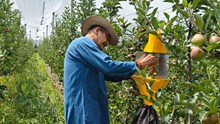
On June 18, 2025, U.S. Agriculture Secretary Brooke L. Rollins launched an USD 8.5 million sterile New World Screwworm (NWS) fly dispersal facility at Moore Air Base in South Texas and announced a five-pronged plan to stop the return of the deadly pest, aiming to protect livestock, wildlife, pets, and the food supply chain.
The New World Screwworm, a parasitic fly whose larvae feed on living tissue, causing fatal wounds in animals and, in rare cases, affecting humans, was eradicated from the U.S. decades ago. However, recent detections in Mexico, as far north as Oaxaca and Veracruz, roughly 700 miles from the U.S. border, have triggered alarm, leading to a suspension of live cattle, horse, and bison imports through U.S. southern ports of entry since May 11, 2025.
“The United States has defeated NWS before and we will do it again,” said Secretary Rollins. “We do not take lightly the threat NWS poses to our livestock industry, our economy, and our food supply chain.”
The five-pronged strategy includes stopping the pest from spreading in Mexico, protecting the U.S. border, maximizing readiness for a domestic outbreak, launching sterile fly dispersal operations, and investing in innovative technologies to combat the parasite.
The newly launched facility in South Texas will disperse sterile flies into northern Mexico. Combined with expanded operations in Metapa, Mexico, where USDA has invested USD 21 million to produce an additional 60–100 million sterile flies per week, and existing production in Panama, the aim is to release over 160 million sterile flies weekly. USDA is also considering building a domestic sterile fly production facility at Moore Air Base to generate up to 300 million sterile flies per week.
On-the-ground surveillance is being strengthened. APHIS cattle fever tick riders will monitor wildlife and livestock movement along the Rio Grande, and state and federal teams will undergo emergency training. The USDA will also work to ensure adequate supplies of NWS treatments and remove regulatory hurdles for their use.
Texas leaders have welcomed the move. Governor Greg Abbott called the facility a “critical step.” Representatives Monica De La Cruz, Tony Gonzales, Vicente Gonzalez, and others praised the USDA’s swift action.
Farmer groups welcomed the announcement. The National Cattlemen’s Beef Association said sterile fly release remains the “only known way” to stop NWS spread, while the Texas Farm Bureau called the domestic facility “a critical step” in protecting livestock and rural communities.
USDA will hold four public listening sessions to gather input on advanced eradication strategies, including genetically modified flies, better traps and lures, and new sterilization technologies such as e-beam radiation.
















